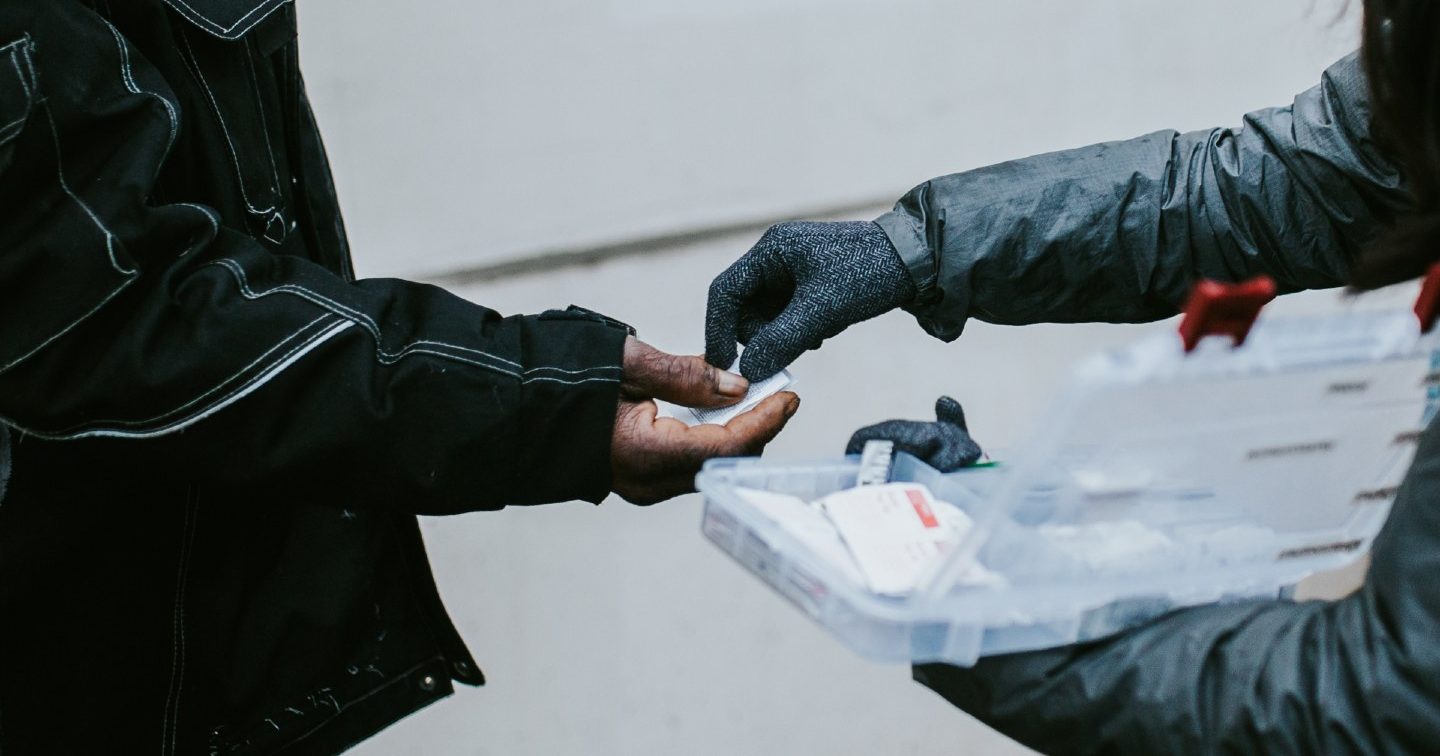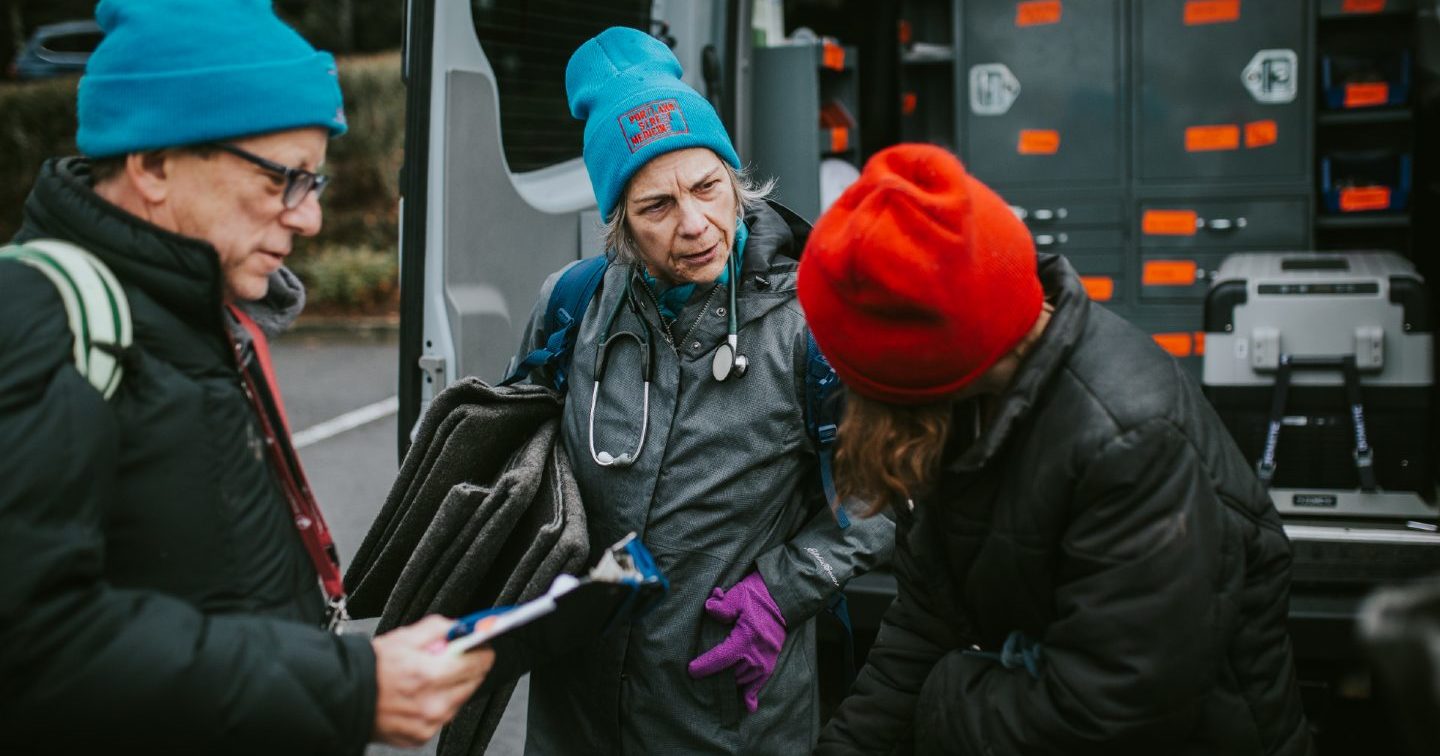EDITOR’S NOTE: The Nation believes that helping readers stay informed about the impact of the coronavirus crisis is a form of public service. For that reason, this article, and all of our coronavirus coverage, is now free. Please subscribe to support our writers and staff, and stay healthy.
On a recent evening in Portland, Oregon, Dr. William Toepper put on a paper surgical mask and made his way down a muddy road toward a row of shelters pitched beneath the fir trees. Smoke drifted up from a small fire tended by two women. One of them stood as he approached. “You doing OK?” he asked.
“Yeah,” she said. “Got any food?”
“We’ve got survivor kits,” Toepper offered, holding out a ziplock bag packed with socks, snacks, antibiotic ointment, and hand sanitizer. “I’ll take one,” the woman said. “I want to survive.”
Toepper, a retired emergency physician, is the medical director of Portland Street Medicine, a group of doctors, nurses, social workers, and other volunteers who provide care to people living on the streets, in camps, or in forests in the Portland area. Volunteers go on rounds three days a week, providing acute care and basic medical supplies and offering to connect people with other services. In the past few weeks PSM volunteers have also been sharing information about Covid-19 as part of a multiorganization effort to protect Portland’s homeless population, estimated at 4,000, during the pandemic.
In the field, Toepper goes by “Dr. Bill.” He’s known this woman, whom I’ll call Hannah, for about two years. Hannah is 40, and she has chronic hypertension. She’s on medication, and she’s feeling better, she told us—“except for all this crap going on,” she added, waving her hands. She was wearing blue latex gloves. “I’m just stressed out really bad.”
Nearby, a man with a short gray beard poked his head out of a tent. He’d been following news about the coronavirus on his phone. Earlier in the day Oregon’s governor issued a stay-home order, closing some businesses and public spaces that many people without housing rely on. “Everything’s going to be shut down for two weeks now?” the man asked. “Probably more like six weeks, yeah,” Toepper replied.
“How are we supposed to eat?” the man said.
More than half a million people across the United States experience homelessness on any given night, and the population faces acute risks from the respiratory virus. Many have underlying health conditions, including chronic lung disease, HIV/AIDS, and mental illness, as well as higher levels of stress, which can weaken the immune system. Even in the absence of a viral pandemic, people experiencing unsheltered homelessness have a mortality rate almost 10 times the general population’s and nearly three times that of people living in shelters. Access to sanitation facilities, limited under ordinary circumstances, has been further complicated as public spaces like libraries close and service providers suspend operations in response to the pandemic.
Popular
"swipe left below to view more authors"Swipe →The first confirmed death from Covid-19 in the US homeless population occurred on March 16 in Silicon Valley; since then, in New York City, at least two others have died, and dozens of people living in shelters have tested positive for the coronavirus. Social distancing is difficult if not impossible in shelter settings, though shelters across the country are taking various measures to try to limit the risk, including opening new temporary facilities to relieve crowding elsewhere. For those living outdoors, survival often depends on social bonds. “It’s a social cohort of people,” Toepper said, culturally and sometimes economically. “It’s tough to distance when your income depends on sex work or canning [collecting cans for the recycling deposit].” He continued, “My sense is that the overall risk of getting [Covid-19] is lower, simply because of the fresh air. But once it hits, it’s going to be less well tolerated.” And if it hits, “the virus doesn’t stay in the homeless encampments. It’s a threat to everyone.”
Farther down the row of campsites, a woman named Julie asked Toepper about the shelter-in-place rules. “I was wondering if they’re possibly going to round us up and put us in camps, and if that’s the case, what’s going to happen to my dog?” she said. “That is certainly not the plan,” he assured her.
Julie asked about the symptoms of the disease, and Brandon Deyo, a registered nurse and PSM volunteer, told her to watch out for cough, fever, and shortness of breath. “The hard part is that hospitals are really busy right now because of this, and there are sick people there, so there are risks,” he said. “But if you’re struggling to breathe, then you should go.”
Earlier, Toepper asked Hannah what her anxiety felt like. He described his own as like a pit in his stomach. “Oh, man,” she said, “it goes right to my heart.”
One of the foundational principles of street medicine is that providers meet people wherever they are. Offering regular care directly can avert unnecessary, expensive trips to the emergency room. It also helps build trust with people who might never visit a hospital or clinic, even if they’re critically ill or injured. “When somebody comes into a health care setting, if they’re not clean or they don’t communicate well or they can’t bring their service dog, it can result in quite traumatic experiences, so they avoid it,” Toepper said. “Our experience on the streets is that people are underutilizing health care.”

Over the past few weeks, Toepper has been grappling with a question that’s both logistical and ethical: How best to provide street medicine, which depends on personal contact, during a viral pandemic? “The difficult thing about doing the work is that contamination measures, distancing, PPE [personal protective equipment]—it’s a little more difficult in some of these chaotic environments,” he said. Some of PSM’s outreach has been scaled back simply because many of its volunteers work in hospitals and are busier than ever because of the virus. “One of us is probably going to get Covid, and I don’t know how that’s going to affect us, to be honest,” he said. That prospect amplifies the need to protect not only PSM’s volunteers but also the people they treat.
Several dozen street medicine programs operate in the US. Recently the Street Medicine Institute, which advises local community groups, released recommendations that outreach teams be limited to essential personnel and that they focus on reducing the “spread of the pandemic, while still providing the best medical care possible to the rough sleeping population.” In Portland, Toepper implemented new protocols for distributing medications and supplies to people, and he and Deyo wore masks.
While Covid-19 complicates the logistics of providing care, the pandemic also makes the work more necessary. In addition to reaching an at-risk population, street medicine can play an important role in public health more broadly. “So much of this work, on a practical level, has always been ER diversion,” Deyo said. That mission “is much more amplified in its importance now,” given the need to focus hospital resources on treating Covid-19.
Beginning on March 11, PSM worked alongside the Multnomah County Department of Public Health and others in an effort to reach as much of the city’s unhoused population as possible with information about Covid-19 and supplies, including hand sanitizer. At first, Toepper said, many of the people they spoke with seemed uninterested or suspicious, but over the course of a week, they became increasingly concerned. Like Julie, many were afraid of being swept up and imprisoned in shelterlike environments.
Advocates argue that Covid-19 should not be used to forcibly move people into shelters. Instead, they’re calling for cities to house people in hotels or other private accommodations during the crisis, and they call for significant increases in funding for housing assistance. “It has never been more clear that housing is health care,” said Diane Yentel, the president and CEO of the National Low Income Housing Coalition, in a statement. Advocates worry not only that the pandemic poses risks to individuals without housing but also that the economic fallout could push others into homelessness. The relief package passed by Congress addressed some of these concerns, providing $4 billion to assist homeless shelters and outreach workers, $1.25 billion for Section 8 housing vouchers, $685 million for public housing, and a limited eviction moratorium. (Governors in Oregon, California, and other states have implemented broader moratoriums on residential evictions.)
In response to the pandemic, Portland, along with other cities, decided to limit its regular sweeps of encampments, in accordance with new guidance from the Centers for Disease Control and Prevention, which advised that clearing camps could “cause people to disperse throughout the community and break connections with service providers.” This will be a reprieve for many people living outdoors in Portland, which, like so many other cities, has been embroiled in contentious debates about housing affordability and the encampments. “The ask from the people living outside is, ‘If we could just stay put for a little while, we’d be better able to clean up, we’d do better, we would have less impact on our city,’” Toepper said. After some initial confusion about whether and how Oregon’s stay-home order affected people without housing, Governor Kate Brown recently clarified that her directive is “not intended to serve as an enforcement mechanism against Oregon’s unsheltered population.”

Later in the evening, Toepper pulled up to a street in Southeast Portland where several tents were set up. He and Deyo went from tent to tent, calling out, “Portland Street Medicine! You guys doing OK? Anybody need any medical attention?” They were greeted by silence. “It’s eerie,” said Toepper.
They approached a beige RV. A small dog leaped against its windows, barking. The woman who came to the door introduced herself as Dee. She described a long list of past and present health problems, including cancer, multiple sclerosis, and fibromyalgia. Deyo asked if she’d been following the news about Covid-19. She said no; she didn’t have Internet access. She’d heard that there was a virus going around but didn’t know the symptoms. “It sounds like you might be pretty high risk,” Deyo told her. When he explained that she should watch out for fever, coughing, and shortness of breath, she cut in: “You’re talking about my life.”
Throughout the evening, Toepper and Deyo passed out water, the assembled survival packs, and simple medications, depending on what people said they needed—Motrin, antacids, sterile saline for a man who’d split his finger open and had been told he’d need surgery. With many hospitals postponing nonessential procedures because of the pandemic, it wasn’t clear when that could happen.
The next day, Toepper called me. He wanted to underscore the fundamental point of street medicine. It is, of course, to treat medical ailments, he said. “But to explain the work by the minuscule, tiny tasks you see doesn’t really capture it.” Think about the microbiome, he suggested—the bacteria, viruses, and other microorganisms “that keep us alive and sometimes kill us, but mostly keep us alive.” Our microbiomes aren’t ours alone; they’re shaped by our environment and who we come in contact with. So are the nonbiological things that make us who we are, he continued. The pandemic illustrates this interdependence in a particularly stark way. “You can’t keep a community healthy if you don’t keep the least-healthy in mind and cared for,” said Toepper. “We are not all living alone, you know?”


